Wales is a treasure trove for bird lovers, offering a variety of habitats where numerous species build their nests. From the bustling cliffs of Pembrokeshire to the serene wetlands, birds that nest in Wales include some of the UK’s most iconic and rare species. Whether you’re a seasoned birdwatcher or a curious beginner, this guide will introduce you to the diverse avian life that thrives in this breath-taking region.
Common Birds That Nest in Wales
Wales’ varied landscape supports a dazzling array of bird species. Each habitat, from rugged cliffs to ancient woodlands, is home to different types of nesting birds. Below are some of the most notable species.
Seabirds of Wales
Wales’ coastline is a bustling hub of seabird activity, especially during nesting season.
- Puffins: These charismatic birds are known for their brightly colored beaks and comical waddles. They nest in burrows on islands like Skomer, where they share the space with razorbills and guillemots.
- Gannets: With dramatic dives into the sea, gannets are a spectacle to behold. The largest gannet colony in Wales is found on Grassholm Island, home to over 39,000 pairs.
Woodland Birds
Wales’ ancient woodlands are teeming with life, providing ideal nesting conditions for woodland species.
- Redstarts: These migratory birds are a favorite sight in Welsh forests. Their bright plumage and melodious song make them a delight to spot during spring.
- Great Spotted Woodpecker: Found in mature woods, these birds can often be heard drumming on tree trunks as they establish their nesting sites.
Upland Nesters
The upland areas of Wales, including Snowdonia, are perfect for birds adapted to higher altitudes.
- Red Kites: Once nearly extinct in the UK, these majestic birds now thrive in central Wales, thanks to conservation efforts.
- Skylarks: Known for their soaring flight and cascading song, skylarks nest in upland meadows and grasslands.
Best Places to Spot Nesting Birds in Wales
Wales offers countless opportunities to observe nesting birds in their natural habitats. Here are the top locations bird enthusiasts shouldn’t miss.
Pembrokeshire Coast
The Pembrokeshire Coast National Park is famous for its seabird colonies.
- Skomer Island: A must-visit for puffin lovers, Skomer comes alive with seabirds during the breeding season. Don’t miss the chance to spot pufflings (puffin chicks) here!
- Ramsey Island: Known for its nesting choughs and peregrine falcons, Ramsey is a prime spot for birdwatching.
Snowdonia National Park
Snowdonia’s dramatic landscapes support a range of upland bird species.
- The upland meadows are key habitats for ground-nesting birds like curlews.
- Wetland areas in Snowdonia also attract migratory species during nesting season.
RSPB Reserves in Wales

The RSPB reserves are vital sanctuaries for birds that nest in Wales.
- Newport Wetlands: A haven for reed-nesting birds such as warblers and bitterns.
- Ynys-hir Reserve: This site offers a mix of woodland and wetland habitats, making it ideal for diverse bird species.
Learn more about these reserves from RSPB Wales.
Seasonal Nesting Patterns of Welsh Birds
The nesting season in Wales changes with the seasons, offering unique opportunities throughout the year.
- Spring: Migratory birds like swallows, cuckoos, and chiffchaffs arrive to begin nesting. This is the busiest time for birdwatchers.
- Summer: By early summer, nests are filled with chicks. This is the perfect time to witness feeding behaviors.
- Winter: While most nesting activities have concluded, some species overwinter in Wales, and you might still see resident birds preparing for spring.
Conservation Efforts for Birds That Nest in Wales
Protecting bird habitats is essential for maintaining the rich biodiversity of Wales.
- Red Kite Reintroduction: One of Wales’ greatest conservation successes, this project brought red kites back from the brink of extinction.
- Local Organizations: Groups like The Wildlife Trust of South and West Wales actively work to safeguard nesting habitats.
- Challenges like climate change and habitat destruction require ongoing attention to ensure the future of Welsh birds.
How to Ethically Observe Nesting Birds in Wales
Birdwatching is a rewarding activity, but observing nesting birds requires care to ensure their safety and well-being. Here are some essential guidelines:
- Maintain Distance: Use binoculars or a spotting scope to observe nests from afar. Getting too close can stress the birds and even lead to nest abandonment.
- Stay Quiet: Loud noises can disturb nesting birds, causing them to flee and leave their eggs or chicks vulnerable.
- Avoid Nest Areas: During nesting season, some areas may be restricted. Always respect signs and avoid disturbing roped-off zones, especially in reserves like Skomer Island.
- Use Responsible Photography Practices: Refrain from using flashes or attempting to stage photos that could disrupt natural behaviors.
Following these guidelines helps preserve Wales’ incredible bird populations for future generations.
Conclusion
From the iconic puffins of Skomer Island to the majestic red kites of Mid Wales, birds that nest in Wales offer a glimpse into the region’s vibrant biodiversity. By exploring top nesting sites like Snowdonia and Pembrokeshire, you can witness the incredible variety of birds that call Wales home. Remember to respect these delicate ecosystems to ensure their preservation for future generations.

